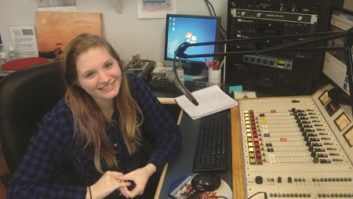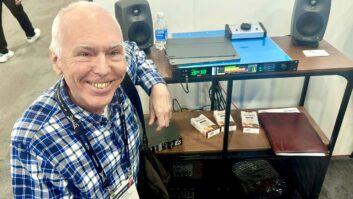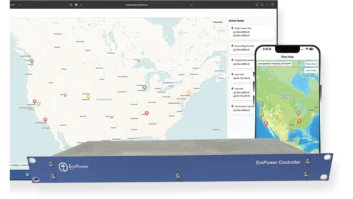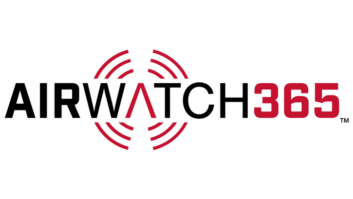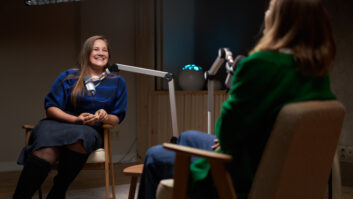The author is general manager and chief engineer of WHCP(LP), Cambridge, Md., and former executive director of NPR Labs. This is the second part in this case-study series about this low-power radio station, here covering funding, equipment and studio space. Part 1 appeared in the Aug. 13, 2014 issue; see radioworld.com/whcp1.

Remnants of an osprey nest are visible on the Cambridge municipal tower. WHCP would like to locate its antenna on the 160-foot Rohn tower.
Credit: Photo by Mike StarlingCAMBRIDGE, MD. — The all-volunteer staff at WHCP Radio has reached more than 80 percent of our construction budget goal, largely thanks to generous donations from engineers and stations around the country.
From a QEI Mod Monitor to an on-air skimmer, from a half-dozen recent vintage computers to almost new CD recorders, a gently used audio switcher to venerable Pacific Recording consoles, vintage microphones to loudspeakers, we are excited by the outpouring of support received to date. It appears that instead of building a modest, bare bones low-power FM, we are on the brink of commissioning a multi-studio, near state-of-the-art community radio complex.
ORGANIZATIONAL STRUCTURE
In rapid order, we grew our fledgling organization to a half-dozen accomplished board members, with half of us having prior radio experience. We’ve now got journalists, lawyers, fund-raisers, technical and programming pros steering the good ship WHCP.
Additionally, thanks to the IRS’s new streamlined 1023EZ form, Cambridge Community Radio Inc. was formally recognized as a 501(c)3 nonprofit, retroactive to our date of incorporation within weeks of our 2014 application. That means all of the equipment and cash donations we’ve received can be recognized with a tax donation letter for the donors.

The Wallace Office building, a Civil War office used by Col. James W. Wallace for enlisting local troops and militia, is under restoration and will not be available for use in time for WHCP sign-on. Note the Cambridge Courthouse in the rear.
Credit: Photo by Mike Starling THE CASE OF THE MISSING TOWER
It has been said that plans of battle never survive first contact with the enemy. In the case of our preferred antenna location, we have been negotiating for use of the centrally located city municipal tower right in the heart of Cambridge.
It is a 160-foot Rohn tower that was built and commissioned in 1978. The tower was constructed to host the city police department repeater, but that moved years ago to the new public safety tower a couple of miles away. The only active use of the tower at present is the very large osprey nest at about 80 feet up the structure.
Although none of the antennas that remain on the tower is in use, there is generator power for the building since it was the original police headquarters. That’s a real plus for city government operations, and should be the same for WHCP in case of any widespread power outages. A little uninterruptible power supply should mean no discernible downtime in the few seconds required for the generator to come online.
The only problem was there did not appear to be an Antenna Structure Registration for this tower on the FCC’s website. On further investigation, we believe we found it — a mere 800 meters to the southwest. Apparently, due to an error in filing the tower application back in 1978, the coordinates were garbled. We’re pretty confident that is what happened because the overall height and type of tower are identical; even the street address is where the tower actually is and the stipulated height above average terrain is also identical.
But since there’s not a valid ASR on file with the commission, there’s no way to request that tower as our new antenna location. It gets better — since we are within the specified distance to the Cambridge Municipal Airport, an FAA notification on FAA Form 7460 is now required to correct the tower’s location, after a mere 36 years of administrative misplacement.
The good news is once it has been cleared by the FAA, a corrected Antenna Structure Registration can be filed, and then our request for the move of less than 1 kilometer to that location at 100-foot HAAT. The FCC’s LPFM expert Gary Loehrs and FAA antenna expert Diegenes Ramos could not have been more helpful in explaining how to efficiently take care of the issue. If anyone has anything unkind to say about the caliber and dedication of federal workers today, they can meet me in the alley.
Seriously, the cable companies and wireless providers should contract with the FCC and FAA on how to properly handle customer service and technical support. As always, good communication, solid knowledge and caring about the inquiry are the keys to happy customer service.

The vacant water pumping station by the Cambridge Marina frequently floods.
Credit: Photo by Mike Starling One decision that was under study was electing not to go for the maximum height on the tower because of the power derating considerations once an LPFM goes above 100 feet Height Above Average Terrain. Normally, any engineer would go for maximum height and distance. As we all know, FM is basically a line-of-sight proposition.
However, for us, going to the top of the tower would have reduced our ERP to a mere 35 watts. But in our case, the town of Cambridge itself is where 75 to 80 percent of our potential audience lives, no matter how high we get up on the tower.
Nearby areas are simply very sparsely populated until you reach the next communities of size, which are well beyond the 60 dBu contour. Thus, we are sacrificing some theoretical “fringe” service in favor of another 5 dB of signal flux density in town for maximum building penetration.
This should mean less of the classic “try moving your radio closer to the window” technical support calls. The folks at V-Soft modeled the coverage tradeoffs for us, vividly documenting the antenna height recommendation from consulting engineer Gray Haertig, owner and principal engineer of Gray Frierson Haertig & Associates.
As we’ve been telling potential listeners in outlying areas, we’ll be available online worldwide — even at their house — and will consider applying for a community translator or two if nearby smaller communities are clamoring for a better signal.
RADIO CALENDAR
The WHCP board pointed out our good fortune with equipment donations needs to be matched with a cash buffer in the bank to consider the serious commitment of leasing prime studio space downtown. We all agree that’s the kind of visibility, access and stake in the community we would prefer to have.
So, we considered the usual fundraising activities — silent auction, gala, community flea market, music festival, etc. In the end, we talked about what a great community we have here that in recent years has exploded with a different “destination event” seemingly every weekend throughout the summer. In fact, there are now so many events hosted in Cambridge, we agreed none of us could possibly name them all — let alone the dates on which they occur.

WHCP board members gather to review the Cambridge Community Calendar printer proofs. From left, Steve Rideout, Chuck McFadden, Mike Starling, Paul Clipper, Nancy Barger, Karen Fishell (attending by phone: Paul Littleton).
Credit: Photo by Jill Jasuta For the many locals hosting friends and family all summer long it’s a challenge finding which event to match with which visitors. Another factor entered our thinking — this is such a scenic area, and home to so many accomplished photographers, what if we combined the best of local postcard quality photography with consolidated documentation of events coming in 2015 via a first-ever Cambridge Community Calendar?
So in October we sent out the call for well-known photographers to submit their best works for editorial consideration. And we fanned out to consolidate the best various partial lists of event dates, and added in the local public school calendar days off and even the dates for the opening of various hunting seasons.
Thanks to Jill Jasuta, our ace layout editor, more than a thousand calendars arrived on Dec. 3, just in time for placement in over a dozen local merchants. Naturally we put the word out on Facebook and our website (www.whcpradio.org), and at $12 per calendar the sales have been brisk so far.
For a $25 station membership, a calendar is included. Regardless of final net income, this initiative embodies the kind of positive spirit we strive for in our slogan “Cambridge, MD — A Great Place to Be!”

Pacific Research & Engineering recording consoles are ready to ship at Wyoming Public Radio, where Chief Engineer Reid Fletcher packed the crates.STUDIO LOCATION, PROGRAM PLANNING
Like many other LPFMs we’ve found some excellent studio space at affordable rates on the second floor of a couple of prime downtown buildings. The only issues are lack of street level visibility and more importantly, accessibility.
As a federally licensed station, of course, we would need to have alternate first floor space for guest interviews with anyone with limited mobility. That’s likely doable, but all things being equal, first floor space with constant street visibility would be preferable.
Two great little buildings were initially in the running — the kind of quaint “Northern Exposure/Talkeetna Community Radio” cozy studio venues many of us fancy in community radio. The water pumping station by the Cambridge Marina is vacant, but the grounds frequently flood at high ebb tides and during tropical storms. Also, the Wallace Office building, a Civil War office used by Col. James W. Wallace for enlisting local troops and militia, has significant historical renovations underway that will extend long beyond our spring on-air date.
Each building was borderline in terms of space at roughly 450 square feet. Ideally, we need at least 500 square feet for a decent master control room, production room and shared office space. Volunteer carpenters and cabinet makers are standing by!
Another excellent, nearly free downtown building in a “transitional” block has been offered, but also will not be available for many months past our deadline. So, we were still looking as of mid-December.
WHCP made a public debut during the Cambridge Showcase for nonprofits along High Street in October. We had the station on-air for equipment testing and recorded station breaks by more than three dozen citizens who stopped by the booth.

This calendar is included with a $25 membership.
Credit: Photo by Graham Slaughter The best ones are the little kids who couldn’t read the script yet but were great at memorizing it. The mayor and commissioners recorded breaks for us, and some of the best cuts are actually the hilarious out-takes of folks stumbling a bit and then nailing it with the recorder rolling. These will be great to drop in among the programming once we go live.
In fact, we’re thinking a “claim your 15 seconds of fame” campaign will be a great way to get anyone interested involved as we go on-air. Nothing beats folks saying they heard you on the radio today to get everyone tuning in.
As is supposedly attributed to Edward Murrow, “in the final analysis, all that matters is what comes out of the loudspeaker,” it’s time to shift to the real work of assembling a great program schedule. Our first big community meeting is coming up, tentatively slated for Saturday, Jan. 24, complete with a skills inventory of potential volunteers.
The Programming Committee is scrutinizing the dozens of free weekly program offerings from the Public Radio Satellite System and Public Radio Exchange. The PRSS has a special incentive for new LPFMs of only $250 to join during the first year and take feeds as an Internet-only station. That provides access to a wealth of free programming from around the country to match niche programming interests in the community.
It’s exciting to drive around town during equipment testing with the Nautel VS-300 lit up at our original temporary studio and transmitter location on 101.7 FM. It’ll be even more so in our permanent home, which will keep us busy nailing down in the coming weeks. We can’t wait to circle the actual WHCP Radio sign-on date on our 2015 Community Radio Calendars.
Share your own LPFM stories. Email[email protected].
